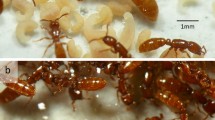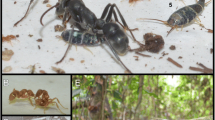Summary
-
1.
Eurhopalothrix heliscata n. sp. is an Asiatic representative of the little known ant tribe Basicerotini and the first member of the group to be studied intensively. We report evidence that it preys on a variety of termites, but also takes at least some other kinds of insects. Overall, the social behavior is simple relative to that of many other myrmicine ants.
-
2.
Prey are hunted and retrieved singly. But foraging workers are also able to recruit nestmates to the vicinity of groups of prey and as a result accelerate retrieval of termites to the brood chambers. A prolonged exploration of the surrounding area also ensues.
-
3.
With the aid of chemical cues, workers are able to recognize material from the vicinity of their nest.
-
4.
The workers are notably thigmotactic. They use their wedge-shaped heads, hard bodies, and short legs to press into tight spaces. They seize the appendages of termites with their short, sharp-toothed mandibles, clasping these body parts of the prey even more tightly with the aid of their projecting, heavily sclerotized labra.
-
5.
E. heliscata tend to gather in large, broodless groups away from the main part of the colony. This bivouacing behavior, which effectively dispenses the foragers over a wider area, may improve the efficiency of the predation on termites.
-
6.
The workers appear not to practice food exchange, worker oviposition, or alarmdefense behavior, nor do they recruit during colony emigration.
-
7.
Prolonged fighting and dominance-subordinance relations among queens have been observed under laboratory conditions.
-
8.
Other details of nesting behavior and social interactions are described (see,e.g., table I).
Zusammenfassung
-
1.
Eurhopalothrix heliscata n. sp. ist eine asiatische Vertreterin des wenig bekannten Ameisen-Tribus Basicerotini. Es ist die erste Angehorige dieser Gruppe, die genau unter-sucht wurde. Es erbeutet Termiten, nimmt aber auch einige Insekten als Beute an. Im Vergleich zu vielen anderen Myrmicinen ist ihr soziales Verhalten einfach.
-
2.
E. heliscata ist eine Einzeljagerin. Wenn mehrere Beuteobjekte gefunden werden, konnen Arbeiterinnen Nestgenossinnen rekrutieren; das beschleunigt das Eintragen der Beute. Das fuhrt oft auch zu einer ausgedehnten Erkundung der weiteren Umgebung.
-
3.
Arbeiterinnen erkennen chemisch Material aus der Nahe ihres Nestes.
-
4.
Die Arbeiterinnen sind bemerkenswert thigmotaktisch. Mit ihren keilformigen Kopfen, harten Korpern und kurzen Beinen drucken sie sich in enge Raume. Mit ihren scharfgezahnten Mandibeln ergreifen sie die Extremitaten der Termiten und sie packen die Beute noch fester mit ihren stark sklerotisierten Labra.
-
5.
E. heliscata versammeln sich oft in Gruppen, ohne Brut und weg von der Hauptkolonie. Dieses Bivouac-Verhalten, das die Furagiere über eine weitere Flache verteilt, scheint der Termitenjagd gut angepasst zu sein.
-
6.
Futteraustausch, Eier legende Arbeiterinnen, Alarm-Verteidigungsverhalten und Rekrutierung wahrend Nest-Emigration wurden nicht beobachtet.
-
7.
Im Labornest kampfen die Koniginnen haufig miteinander und zeigen ausgepragtes Dominanzverhalten.
-
8.
Weitere Einzelheiten zum Nest- und Sozialverhalten werden beschrieben (sieheTabelle I).
Similar content being viewed by others
References
Bartz S., Hölldobler B., 1982.—Colony founding inMymecocystus mimicus Wheeler (Hymenoptera: Formicidae).Behav. Ecol. Sociobiol., 10, 137–147.
Brown W.L., 1980.—Protalaridris genus nov.,Protalaridris armata species nov. (Insecta: Hymenoptera: Formicidae: Myrmicinae: Basicerotini).Pilot Register of Zoology, 36, 37.
Brown W.L., Kempf W.W., 1960.—A world revision of the ant tribe Basicerotini.Studia Entomol. (Rio de Janeiro),3, 161–250.
Brown W.L., Wilson E.O., 1959.—The evolution of the dacetine ants.Quart. Rev. Biol., 34, 278–294.
Fagen R.M., Goldman R.N., 1977.—Behavioural catalogue analysis methods.Anim. Behav., 25, 261–274.
Hölldobler B., 1981.—Trail communication in the dacetine antOrectognathus versicolor (Hymenoptera: Formicidae).Psyche (Cambridge, Mass.),88, 245–257.
Imai H.T., Crozier R.H., Taylor R.W., 1977.—Karyotype evolution in Australian ants.Chromosoma (Berlin),59, 341–393.
Taylor R.W., 1968.—Notes on the Indo-Australian basicerotine ants (Hymenoptera: Formicidae).Austral. J. Zool., 16, 333–348.
Taylor R.W., 1970.—Notes on some Australian and Melanesian basicerotine ants (Hymenoptera: Formicidae).J. Austral. Ent. Soc., 9, 49–52.
Taylor R.W., 1980.—Australian and Melanesian ants of the genusEurhopalothrix Brown and Kempf—notes and new species (Hymenoptera: Formicidae).J. Austral. Ent. Soc., 19, 229–239.
Wheeler G.C., Wheeler J., 1954.—The ant larvae of the myrmicine tribes Basicerotini and Dacetini.Psyche (Cambridge, Mass.),61, 111–145.
Wheeler G.C., Wheeler J., 1960.—Supplementary studies on the larvae of the Myrmicinae (Hymenoptera: Formicidae).Proc. Entomol. Soc. Washington, 62, 1–32.
Wilson E.O., 1956.—Feeding behavior in the antRhopalothrix biroi Szabó.Psyche (Cambridge, Mass.),63, 21–23.
Wilson E.O., 1962.—Behavior ofDaceton armigerum (Latreille), with a classification of self-grooming movements in ants.Bull. Mus. Comp. Zool. Harv., 127, 403–421.
Wilson E.O., 1971.—The insect societies. Belknap Press of Harvard University Press, Cambridge, Mass.
Wilson E.O., 1984.—The relation between caste ratios and division of labor in the ant genusPheidole (Hymenoptera: Formicidae).Behav. Ecol. Sociobiol., 16, 89–98.
Author information
Authors and Affiliations
Rights and permissions
About this article
Cite this article
Wilson, E.O., Brown, W.L. Behavior of the cryptobiotic predaceous antEurhopalothrix heliscata, n. sp. (Hymenoptera: Formicidae: Basicerotini). Ins. Soc 31, 408–428 (1984). https://doi.org/10.1007/BF02223657
Received:
Accepted:
Issue Date:
DOI: https://doi.org/10.1007/BF02223657




